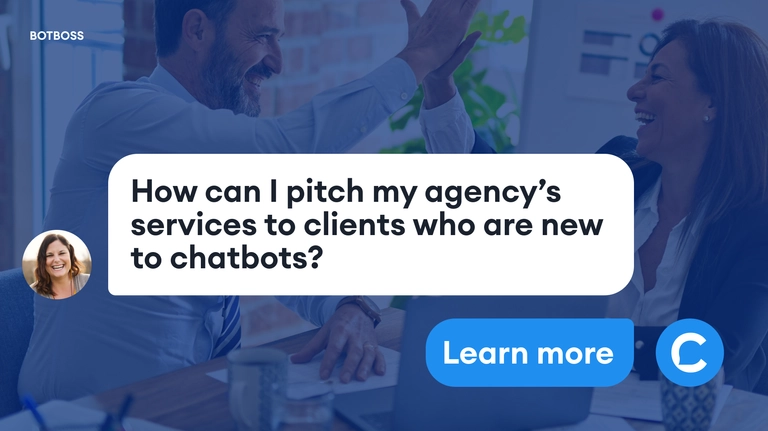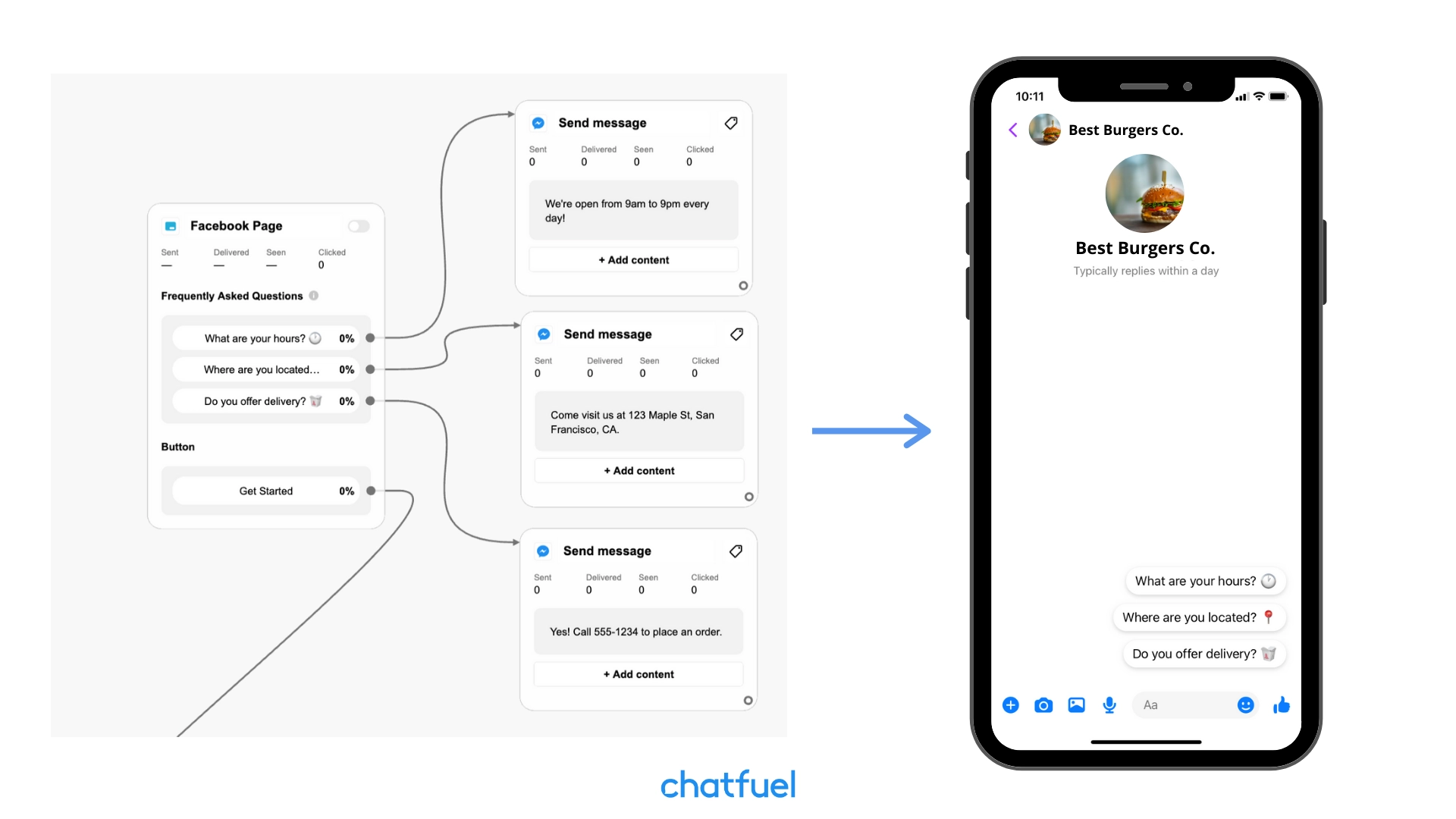
How to pitch your agency's services to customers who are new to chatbots
Pitching your chatbot marketing agency's services to a client who doesn't know about bots? Here are four tips to help you close the deal.
When you’ve been building chatbots for clients for a while, it can sometimes seem as if you speak a different language than the rest of the world. But if this is your business, or an industry you’re trying to get into, explaining the benefits of this technology simply and concisely to prospects is a very important skill. From our extensive experience, here are the most important principles a chatbot marketing agency should stick to during the Why you need a chatbot conversation with a prospective client. Follow them so you can help prospects easily understand what this technology—and your services—can do for them so you can close the deal.
- Focus on the problems a chatbot can solve
A person who has never used a Messenger bot before will most likely get confused if you start pitching an automated robot that will talk to their customers. At worst, it sounds scary! And at best, you’ll sound like a crazy tech person who wants to sell the next shiny thing on the internet.
Instead, approach the conversation from the perspective of what their business is struggling with at the moment. What’s a problem they face every day that a chatbot can easily take care of? To give you inspiration, here are a few of the most common ones.
I get too many messages on Facebook asking the same things
Many business owners (especially the smaller ecommerce stores) have this problem. Every day, they get bombarded with dozens or even hundreds of questions about the same things: contact details, shipping information, payment options, etc. Fortunately, as you know, these and other frequently asked questions can be automated using a Messenger chatbot. (You can even set up a bot to answer these questions before the user asks them, thanks to Ice Breakers.)

I can’t respond to prospects fast enough
In the age of social media, speed is the name of the game. 43% of consumers expect that online businesses will be responsive and provide service 24/7. So if you don’t respond fast enough, your lead will become someone else’s customer.
Fortunately, chatbots don’t need lunch breaks and rarely go on vacation. That’s why a chatbot is the perfect “employee” to help fulfill your customers' high expectations and increase those conversion rates. While bots aren’t meant to replace human employees entirely, they can handle the repetitive inquiries around the clock so your client’s human employees can focus on more complex tasks.
I’m losing sales because I forget to follow up with leads
For some products and services, leads simply need more touch points from the business to get them to purchase. This is especially true for high-ticket items and complex services. Unless your prospective client has a team of highly trained salespeople and a great tech stack, it’s likely they’re not following up with each lead at the right time.
A Facebook Messenger chatbot can make that process easier and more efficient by reengaging the leads on its own, automatically. For a business, that means fewer forgotten tasks, less frustration, and more sales.
As a Messenger chatbot agency focusing on this objective, you’ll want to look into:
These are all great tools for building chatbots that can successfully reengage a client’s leads and get them to make a purchase.
I can’t manage to respond to all the comments on my business’s Facebook posts
If the client’s business has an engaged online community and gets lots of comments on their Facebook page posts, that’s a huge opportunity! Humans can often overlook some of the comments and leave them without a response. But—you guessed it—a Messenger chatbot won’t miss any. It can be set to respond as soon as a person comments on a post (or after a delay, if you prefer). The Comments Autoreply functionality can be used for contests and giveaways, but also to provide more information about the client’s business and their products or services.
- Showcase results
Once you’ve established what kind of a problem the business is struggling with, let them know that this is something that can be resolved with a chatbot (instead of with expensive software or by hiring extra people).
If your chatbot development agency already has successful past projects, add these to a portfolio that’s easy to share with your new prospects. Focus on exactly what your prospective client needs, and tell them how you’ve done it successfully for other clients before.
If they’re interested in spending less time responding to messages, for example, tell them how you’ve automated responses for other businesses in the past. In this case, don’t focus on the number of users this other chatbot had, or how many reengage messages you had it send. Instead, highlight the metrics that matter to them: the hours the bot saved your previous client and the lightning-fast response times it helped them achieve.
But what if you’re just getting started in the chat bot marketing industry, and you don’t have any results to back you? In this case, feel free to use our library of case studies to show what bots have achieved for other businesses.
Popular case studies you might find useful
- Whisky brand triples conversion rates with gift-recommendation bot.
- HelloFresh cuts response times by 76% with a chatbot.
- Baby-furniture brand generates 80% of sales on autopilot with a chatbot.
- Call center cuts monthly costs by $25,000 with a lead qualification chatbot.
It would also be useful to build out a simple flow to demo what a Facebook chatbot could look like for your prospect. Then, you can share the flow so they can interact with it themselves to understand the experience their audience will get to enjoy.
There are many actionable examples of how to do this in Chatfuel Academy, our four-week online course for agencies. More on this in the last section.
- Avoid “tech speak”
Especially during the first conversation, try not to use complex chatbot terms that your prospect won’t understand (like API, Entry Point, attributes, analytics terms, etc.). Even throwing in just a few without explanation can make the prospect confused and lead them to believe this technology is too complex or advanced for their needs.
Some of our agencies have found that it can be useful to call the chatbot a “virtual assistant” instead. They explain that it’s like an additional team member that can answer questions and send follow-up messages when necessary. That’s just one example of a different phrase you could use to explain the solution to your prospect; it may be helpful to experiment with a few different terms and see what they respond to best.
Reengaging, Comment Acquisition, and Flow Builder are also terms you should stay away from. Instead, get to the crux of what these features do—break it down to the basics. Explain that your chatbot agency can design and build a conversation that will guide their audience through their products/services, respond to questions, and upsell to interested users. Even if you’re explaining a complex concept, break it down into what’s visible to the business owner and explain how it will impact their day-to-day.
- Set clear expectations
If you’ve been building chatbots for clients for a while, this is a no-brainer for you. These types of projects require positioning yourself and your chatbot agency as the experts and guiding your client through the process. But if you’re just starting out, there are a few peculiarities you should keep in mind.
For example, in the discovery stage, you need to be on the same page with your client about how long it will take to create their chatbot and how much it will cost. You’ll also want to be very clear about how involved the client needs to be in the process. Do they need to provide you with more information or visual content you’ll be using in the Messenger bot? How much control will you give them when it comes to the content of the chatbot itself?
Finally, don’t forget that a chatbot isn’t a “set it and forget it” kind of tool. Maybe it needs customer support agents standing by to respond to the more complex questions. Maybe it needs sales managers to take over with the qualified leads. It definitely will need regular performance reviews) and flow adjustments. Who will be in charge of the ongoing maintenance in that case? Will you be charging a monthly maintenance fee, or will the client be bringing you in periodically?
Chatfuel Academy has a whole module dedicated to these technical details to help you ensure a smooth chatbot sales process. Our expert instructors cover:
- the best ways to demo the bot to your client
- the safest ways to hand off the chatbot once it’s ready to be launched
- why and how a chatbot development agency should use the white-labeled dashboard
Set your chatbot agency up for success
In summary, here’s what to do to dramatically increase the odds that you’ll close the deal with your new prospect:
- Focus on how the chatbot is going to make their days better and their business more successful
- Prove it by showcasing results you’ve already achieved for other clients
- Keep your explanations simple and easy to understand
- Make sure you’re on the same page throughout the project
Ready to try it for your business? Get a free account today, and enjoy the difference.
